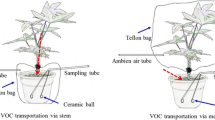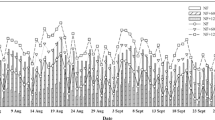Abstract
Fifteen plant species—Alternanthera bettzickiana, Drimiopsis botryoides, Aloe vera, Chlorophytum comosum, Aglaonema commutatum, Cordyline fruticosa, Philodendron martianum, Sansevieria hyacinthoides, Aglaonema rotundum, Fittonia albivenis, Muehlenbeckia platyclada, Tradescantia spathacea, Guzmania lingulata, Zamioculcas zamiifolia, and Cyperus alternifolius—were evaluated for the removal efficiency of xylene from contaminated air. Among the test plants, Z. zamiifolia showed the highest xylene removal efficiency. Xylene was toxic to Z. zamiifolia with an LC50 of 3,464 ppm. Higher concentrations of xylene exhibited damage symptoms, including leaf tips turning yellow, holonecrosis, and hydrosis. TEM images showed that a low concentration of xylene vapors caused minor changes in the chloroplast, while a high concentration caused swollen chloroplasts and damage. The effect of photosynthetic types on xylene removal efficiency suggests that a mixture of Z. zamiifolia, S. hyacinthoides, and A. commutatum which represent facultative CAM, CAM, and C3 plants, is the most suitable system for xylene removal. Therefore, for maximum improvement in removing xylene volatile compounds under various conditions, multiple species are needed. The effect of a plant’s total leaf area on xylene removal indicates that at lower concentrations of xylene, a small leaf area might be as efficient as a large leaf area.




Similar content being viewed by others
References
ATSDR (1995) Toxicological profile for xylenes (update). Public Health Service, US Department of Health and Human Services, Atlanta
ATSDR (2007) Toxicological profile for xylene. US Department of Health and Human Services. Agency for Toxic Substances and Disease Registry, USA
Calabrese EJ, Kenyon EM (1991) Air toxics and risk assessment. Chelsea, MI
Cassana FF, Falqueto AR, Braga EJB, Peters JA, Bacarin MA (2010) Chlorophyll a fluorescence of sweet potato plants cultivated in vitro and during ex vitro acclimatization. Braz J Plant Physiol 22(3):167–170
Collins C, Laturnus F, Nepovim A (2002) Remediation of BTEX and trichloroethene. Environ Sci Pollut Res 9:86–94
Conrejo JJ, Munoz FG, Ma CY, Stewart AJ (1999) Studies on the decontamination of air by plants. Ecotoxicology 8:311–320
Finney DJ (1971) Probit analysis, 3rd edn. Cambridge University Press, Cambridge
Guieysse B, Hort C, Platel V, Ondarts M, Revah S (2008) Biological treatment of indoor air for VOC removal: potential and challenges. Biotechnol Adv 26:398–410
Guo YP, Guo DP, Zhou HF, Hu MJ, Shen YG (2006) Photoinhibition and xanthophylls cycle activity in bayberry (Myrica rubra) leaves induced by high irradiance. Photosynthetica 44:439–446
Holcomb LC, Seabrook BS (1995) Indoor concentrations of volatile organic compounds: implications for comfort, health and regulation. Indoor Environ 4:7–26
Holtum AMJ, Winter K, Weeks AM, Sexton RT (2007) Crassulacean acid metabolism in ZZ plant, Zamioculcas zamiifolia (Aeaceae). Am J Bot 94(10):1670–1676
IPCS (1997) Environmental health criteria 190. WHO, Geneva
Jen MS, Hoylman AM, Edwards NT, Walton BT (1995) Gaseous deposition of 14C-toluene to soybean (Glycine max) foliage. Environ Expt Bot 35(3):389–398
Keymeulen R, Schamp N, Van Langenhove H (1993) Factors effecting airborne monocyclic aromatic hydrocarbon uptake by plants. Atmos Environ 27A(2):175–180
Korte F, Kvesitadze G, Ugrekhelidze D, Gordeziani M, Khatisashvili G, Buadze O, Zaalishvili G, Coulston F (2000) Organic toxicants and plants. Ecotoxicol Environ Saf 47(1):1–26
Kvesitadze E, Sadunishvili T, Kvesitadze G (2009) Mechanisms of organic contaminants uptake and degradation in plants. World Acad Sci Eng Technol 55:458–468
Lee JS (2010) Stomata opening mechanism of CAM plants. J Plant Biol 53:19–23
Liu Y, Mu Y, Zhu Y, Ding H, Arens N (2007) Which ornamental plant species effectively remove benzene from indoor air? Atmos Environ 41:650–654
Maxwell K, Johnson GN (2000) Chlorophyll fluorescence—a practical guide. J Exp Bot 51(345):659–668
Mitchell CS, Zhang J, Sigsgaard T, Jantunen M, Lioy PJ, Samson R, Karol MH (2007) Current state of the science: health effects and indoor environmental quality. Environ Health Perspect 115(6):958–964
Moeckel C, Thomas GO, Barber JL, Jones KC (2008) Uptake and storage of PCBs by plant cuticles. Environ Sci Technol 42(1):100–105
Nelson M, Wolverton BC (2011) Plants + soil/wetland microbes: food crop systems that also clean air and water. Adv Space Res 47:582–590
NIOSH (1988) Recommendations for occupational safety and health standards. Cincinnati, OH: U.S. Department of Health and Human Services, Public Health Service, Centers for Disease Control, National Institute for Occupational Safety and Health. DHHS (NIOSH) Publication No. 88–111
Orwell RL, Wood RA, Burchett MD, Tarran J, Torpy F (2006) The potted-plant microcosm substantially reduces indoor air VOC pollution: II Laboratory study. Water Air Soil Pollut 177:59–80
Sadunishvili T, Kvesitadze E, Betsiashvili M, Kuprava N, Zaalishvili G, Kvesitadze G (2009) Influence of hydrocarbons on plant cell ultrastructure and main metabolic enzymes. World Acad Sci Eng Technol 57:271–276
Sriprapat W, Thiravetyan P (2013) Phytoremediation of BTEX from Indoor Air by Zamioculcas zamiifolia. Water Air Soil Pollut 224(3):1–9
Tarran J, Torpy F, Burchett M (2007) Use of living pot—plants to cleanse indoor air. Research Review, University of Technology Sydney (UTS), Australia
Treesubsuntorn C, Thiravetyan P (2012) Removal of benzene from indoor air by Dracaena sanderiana: effect of wax and stomata. Atmos Environ 57:317–321
Ugrekhelidze D, Korte F, Kvesitadz G (1997) Uptake and transformation of benzene and toluene by plant leaves. Ecotoxicol Environ Saf 37:24–29
Wolverton BC, Johnson A, Bounds K (1989) Interior landscape plants for indoor air pollution abatement. Final Report. NASA Stennis Space Centre MS, USA
Yang DS, Pennisi SV, Son KC, Kays SJ (2009) Screening indoor plants for volatile organic pollutant removal efficiency. HortSci 44(5):1377–1381
Zhou J, Qin F, Su J, J-w L, H-l X (2011) Purification of formaldehyde-polluted air by indoor plants of Araceae, Agavaceae and Liliaceae. J Food Agr Environ 9(3–4):1012–1018
Acknowledgments
The authors would like to thank the Thailand Research Fund for supporting this research through the Royal Golden Jubilee Ph.D. Program, King Mongkut’s University of Technology Thonburi (grant no. PHD/0284/2552).
Author information
Authors and Affiliations
Corresponding author
Additional information
Responsible editor: Constantini Samara
Rights and permissions
About this article
Cite this article
Sriprapat, W., Boraphech, P. & Thiravetyan, P. Factors affecting xylene-contaminated air removal by the ornamental plant Zamioculcas zamiifolia . Environ Sci Pollut Res 21, 2603–2610 (2014). https://doi.org/10.1007/s11356-013-2175-y
Received:
Accepted:
Published:
Issue Date:
DOI: https://doi.org/10.1007/s11356-013-2175-y




